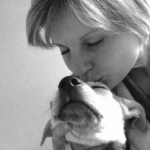
Wild dogs began to hang out around the campsites of early Nomadic pre-historic humans, about 65,000 years ago according to archeological data. By 11,000 years ago, dogs had become an important part of early human culture, to the extent that archeological digs would find people buried with their companion dogs.
A recent study has shown that around 11,000 years ago wild dogs had become so domesticated that their DNA changed from the DNA of wolves and wild dogs, to allow them to better digest grains and carbohydrates.
This change evolved as humans stopped their peripatetic existence and settled down to till the soil and husband livestock for food. Settling down from being hunters and gatherers to being farmers increased the content of carbohydrates in early human diets. Dogs were fed at that time the “left-overs” from their human’s diet, which was increasingly made up of carbohydrates.
These changes in domesticated dog DNA allowed them to digest and utilize the calories and other nutrients found in grains and starchy vegetables.
Dogs do not have a requirement for carbohydrates like they do for protein, fats, water and air, but they can utilize their nutrients nonetheless.
Fast forward about 10,000 years, and in 1860, James Spratt, an American living in London invented the “Dog Cake” which was compounded from blended wheat meals, vegetables, beet root and meat baked into a biscuit. His product was successful in England and from there began sales in the US.
Prior to the invention of the Dog Cake, dogs were fed what they had been fed for the previous 10, 000 years, namely leftovers from human meals. Although leftovers, if properly prepared and balanced when added to a dogs diet can provide a complete and balanced diet for a dog. But it takes a lot of effort and thought to do that, and people just didn’t have the time and attention to detail that using leftovers for balanced meals entails. As a result, nutritional diseases were much more common in pet dogs eating leftovers until diets were provided that were balanced and complete based on available nutritional data.
After Dog Cakes, sales of prepared foods for dogs began to increase markedly as pet owners appreciated the convenience of feeding a pre-packaged meal. Initially the most popular form of pet food was the canned ration. However, during World War II, beginning around 1941, when metal was rationed for use in military vehicles and aircraft, and then when Ralston Purina invented the “extruder” to make kibbled dry food in 1957, dry foods became the most popular food people would buy for their pets. Convenience and long shelf life made these diets very popular, and the dogs loved those crunchy little nuggets!
By 1946 dry foods represented 85% of the pet foods sold in the United States. So, really, pet food as we know it has only been available for the past 70 years or so!
To manufacture a kibbled diet involves making a recipe that will harden when heated and subjected to high pressures in an extrusion machine. In order for the recipe to work, it needs enough starches to hold the kibble together into those little nuggets that dogs love so much. This means that it is very difficult to manufacture a kibble diet with no carbohydrates and high protein. The nuggets just don’t hold together very well.
Additionally, it has been shown in studies of pet food that the high temperatures and pressures used in making kibble can alter the molecular structure of the food and cause it to become less digestible, as well as become pro-inflammatory. Diets that are high in carbohydrates like most kibbles are also known to be pro-inflammatory due to the effect of eating such a large proportion of carbohydrates.
Inflammation will seed the development of a number of chronic diseases such as cancer, diabetes, dermatitis, colitis, hepatitis, pneumonitis, and more. As a holistic veterinarian, its my goal to educate my clients to understand the important role that food plays in the health of their beloved pets, and to give them advice that will help their pets live long and prosper.
Although commercial kibble is much loved by dogs everywhere (and cats,) too, that doesn’t mean its good for them. Would you feed your child candy bars all the time because they love them so much, and cry when you offer something healthy like Brussels sprouts or broccoli? Of course not. So why would you always feed you dog or cat like that?
I’m fond of saying that into each life a little vice can fall, and its OK. I think the occasional meal of kibble, as a convenience to you, or when circumstances preclude feeding a better meal than kibble, its OK to feed that occasional bowl of kibbled commercial food.
For cats, its even more of a problem because cats, unlike dogs have not had changes in their DNA to allow them to digest carbohydrates. For them carbohydrates are much more likely to cause problems like diabetes. In fact, if your cat has diabetes, (Type 2 is the most common form in the cat) feeding it a high protein high fat diet can allow it to not need insulin therapy.
Sometimes, life is busy, our bank account is low, and it becomes necessary to feed a commercial diet. That’s OK, but there are measures you can take to improve the quality of nutrition found in commercial diets. And there are some commercial diets that are better than others, and in the pet food marketplace one can find a number of alternate choices to kibble or canned, such as dehydrated, frozen raw diets, and cooked diets.
By adding digestive enzymes to your pets’ commercial diets you will help them absorb more of the nutrients available in the hard little nuggets of kibble. This can help. RxZyme is an enzyme formula I designed that can be mixed with the food each meal to improve the digestion of their food.
Removing some of the kibble and replacing it with some healthy balanced leftovers from your own meal can help improve your pets’ nourishment. Adding dietary supplements such as the RxVitamins product Nutritional Support for Dogs and Cats, or just adding some flax seed meal, nutritional yeast and lecithin, as well as nutrient herbs can help add back to the kibble what it lost through processing.
Omega three fatty acids as found in hemp seed or flax seed, especially when combined with the omega three oils from fish or krill or algae are very important to include in each meal, as much as your pet or your budget will tolerate. I prefer, when feeding my own dogs and cats, to use flax seed meal and fish oil both for each meal. This seems to make their hair coats shiny and with minimal shedding. I designed RxVitamins’ UltraEFA as a very high quality, very potent and very pure fish oil supplement that has liquid lecithin in it to help with the absorption of the fish oil fatty acids.
Probiotics are live bacteria or yeast that are fed on a daily basis to help improve the ecology of the bowel. They have been found to not just help with digestive function, but also to be good for the immune system. In children with allergies, its been shown that they can improve with just the addition of probiotics daily in their diets. Look for a multiple strain formula that is hypoallergenic with billions of living organisms to inoculate your pet’s digestive system. My own formula, RxBiotic by RxVitamins has 2 billion organisms per 1/8 teaspoon of powder, containing 4 different strains of bacteria in a rice-based formulation.
If you look around this blog-site you will find more information about each of these types of formulas to help your pet who is eating commercial foods receive more value from their meals.




